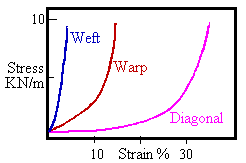
 |
Stress, strain and craquelure - 6 |
I have so far avoided showing the stress-strain diagram for canvas. Canvas can be regarded as a material with very complicated stress-strain behaviour, or as an engineering structure of interweaving yarns, each with a relatively simple stress-strain behaviour. The first view, canvas as one material with complex behaviour, leads to a diagram like this one, for a linen canvas, from Gerry Hedley (1).
 The weft threads are relatively straight. The line on the diagram expresses the stress-strain property of the linen yarn. The warp threads are similar in size but are, in this particular canvas, more crimped, that is they curve more around the warp threads. The low starting modulus is therefore not a property of the warp threads but is due to their uncurling, transfering the crimp over to the weft threads as stress builds up. The low diagonal modulus is because the weave structure deforms very easily into a diamond pattern of threads. At high stress this diamond becomes tight, with all the canvas threads, both warp and weft, now sharing the stress, so that the modulus increases sharply.
The weft threads are relatively straight. The line on the diagram expresses the stress-strain property of the linen yarn. The warp threads are similar in size but are, in this particular canvas, more crimped, that is they curve more around the warp threads. The low starting modulus is therefore not a property of the warp threads but is due to their uncurling, transfering the crimp over to the weft threads as stress builds up. The low diagonal modulus is because the weave structure deforms very easily into a diamond pattern of threads. At high stress this diamond becomes tight, with all the canvas threads, both warp and weft, now sharing the stress, so that the modulus increases sharply.
Such a structure can be partially locked by impregnating it with a material that glues together the crossing points of the threads and obstructs the holes, so that the collapse into a diamond shape is hindered. This can be achieved by glue, commonly used to prepare artists' canvas for the ground coat, or by wax/resin or synthetic polymers, used in conservation treatments such as relining.
Hedley's experiment with wax resin showed just this stiffening effect, but only at low stress, less than 1KN/m (the stress is quoted as KN/m instead of Pa, because it's difficult to work out the cross section of canvas).
The problems that arise if one considers canvas as a single component of the painting structure are well illustrated by Hedley's investigation of the distribution of strain in various parts of a canvas after the simple process of stretching it on a wooden frame (2). He drew circles on an unstretched canvas, stretched it and then measured the deformation of the circles. All the circles had expanded into ellipses but some had a minor axis that was smaller than the diameter of the original circle, apparently indicating that the cloth was in compression (negative strain = negative stress). This is however rather unlikely, or very incompetent handiwork. What has happened is that the stress in one direction, the warp, say, is greater than the force in the weft direction. The crimp moves over so that the weft is now wriggling around the straighter warp threads. The weft is still in tension but the dimension of the canvas in this direction has diminished.
1. Gerry Hedley, The effect of beeswax/resin impregnation on the tensile properties of canvas, in Measured Opinions UKIC 1993, ISBN 1 871656 21 4, pp17-20
2. Op. cit. pp 21-26
The effect of glue size on the mechanics of oil paintings

This work is licensed under a Creative Commons Attribution-Noncommercial-No Derivative Works 3.0 License.